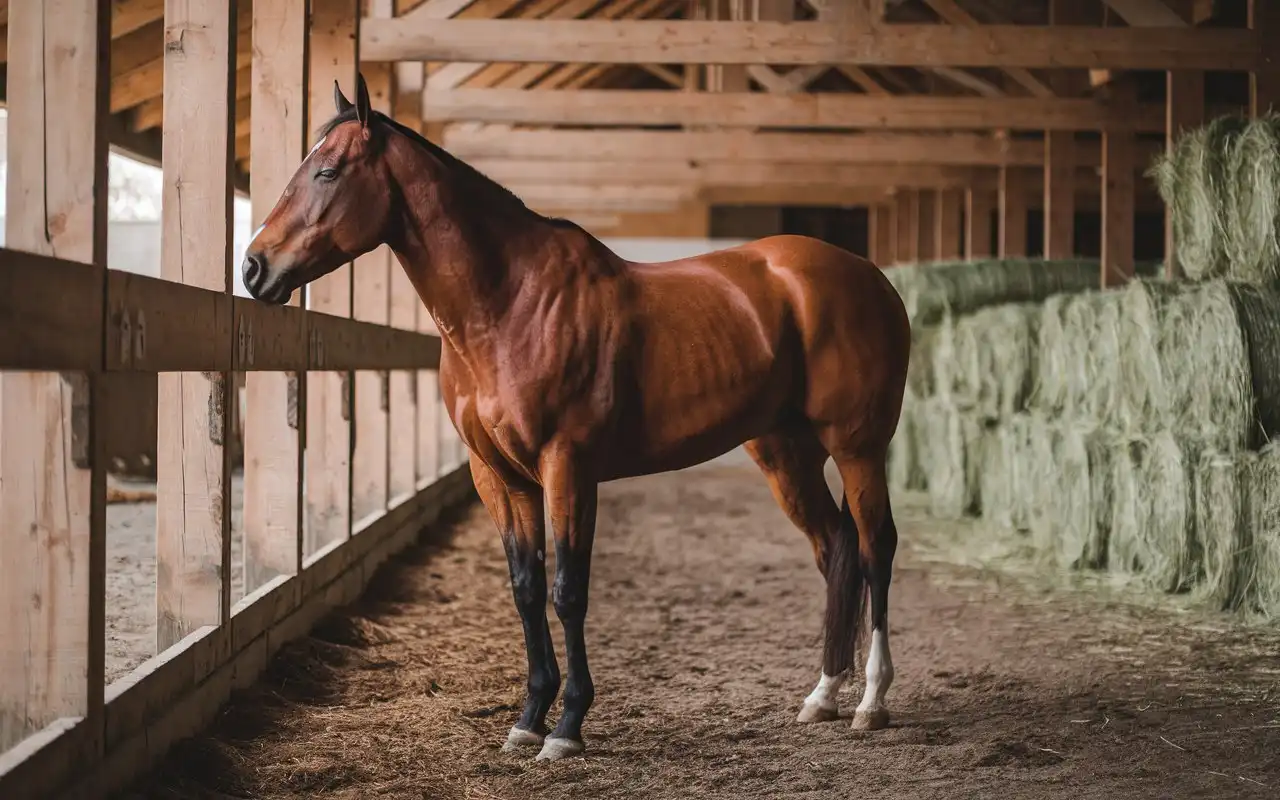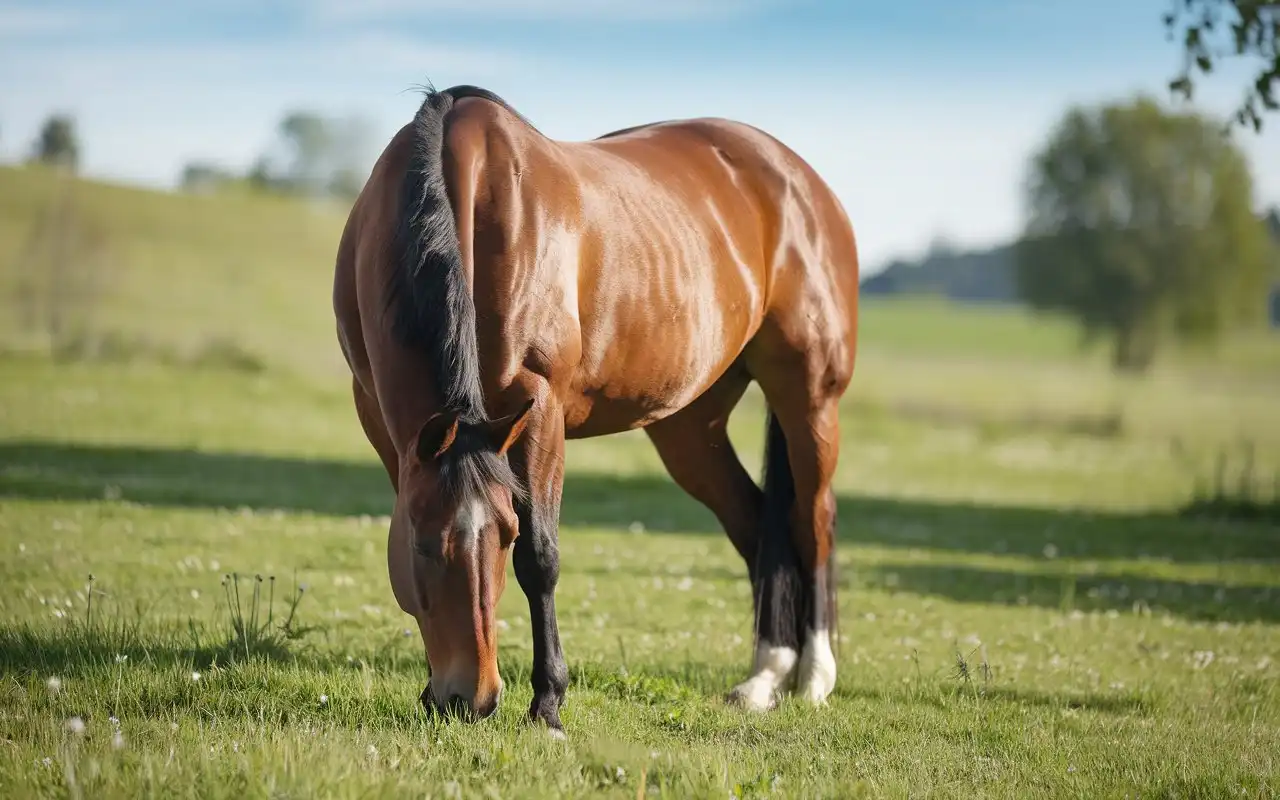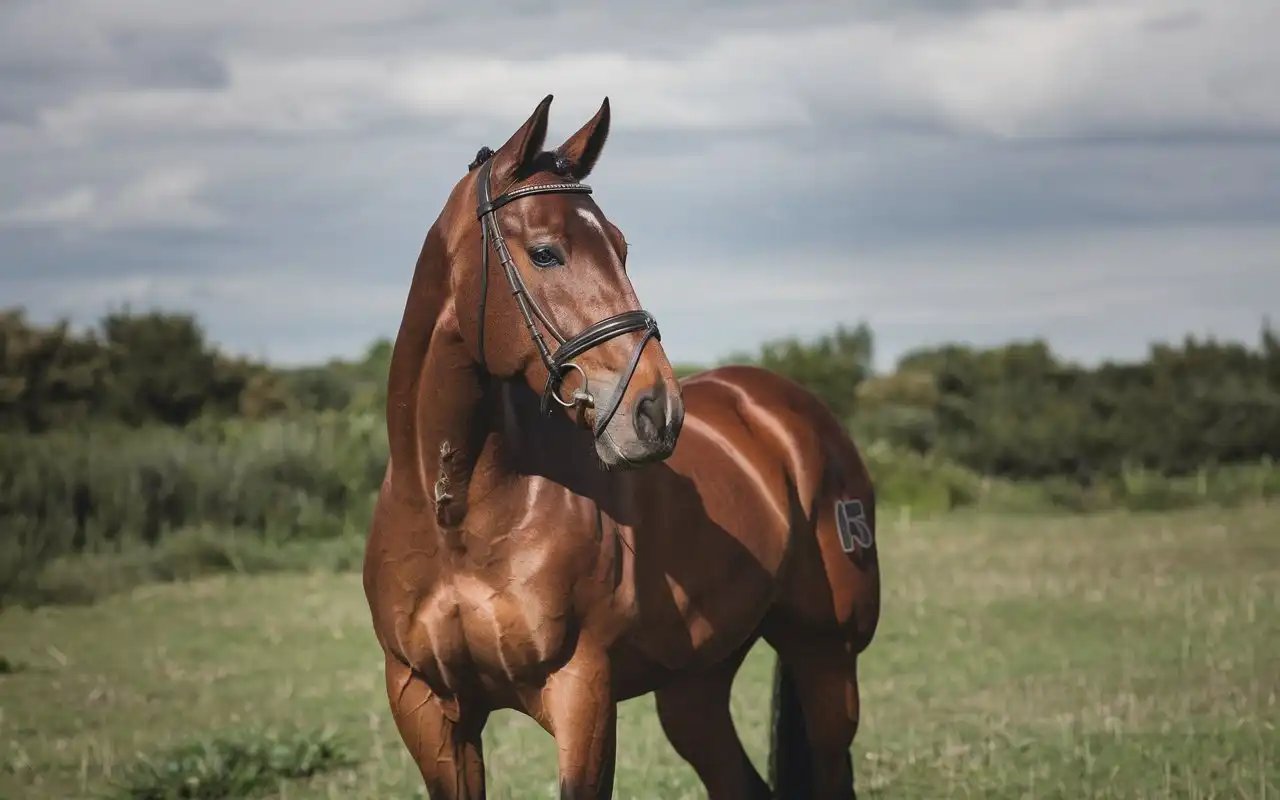Pigeon fever in horses, or Dryland Distemper, is a bacterial infection. It affects equines worldwide, especially in dry, warm climates. Corynebacterium pseudotuberculosis causes the disease. It often leads to abscesses and swelling in infected horses. The chest, abdomen, and limbs are affected. Knowing the signs and treatments can greatly improve the health and recovery of horses with pigeon fever. This guide will cover the causes, spread, symptoms, treatments, and prevention of diseases that all horse owners should know.
Table of Contents
What Causes Pigeon Fever in Horses?
The bacterium Corynebacterium pseudotuberculosis is the primary cause of pigeon fever in horses. This pathogen naturally lives in the soil and thrives in warm, dry climates, particularly in areas prone to dust. When the bacteria come into contact with a horse’s open wound, cut, or even insect bites, it can enter the bloodstream, leading to infection. The bacteria then settle in the body, often creating abscesses as they multiply. While this infection primarily affects horses, it can also infect other livestock, though it is far less common.
The bacteria’s tough resistance makes it hard to eliminate, especially in affected areas. Thus, understanding how it enters a horse’s system is critical for effective prevention.
How Does Pigeon Fever in Horses Spread?
Pigeon fever in horses spreads mainly through contaminated soil and flies. Insects, particularly flies, play a significant role in transmitting the bacteria by landing on open wounds or cuts. Flies that come into contact with an infected horse’s pus or blood can carry the bacteria to other horses, spreading the infection further. Also, horse owners and stable workers can spread the bacteria. They may touch infected horses and then handle healthy ones without proper hygiene.
Dry, dusty conditions in some areas help the spread. Wind can carry contaminated dust to stables or pastures. This exposes horses to bacteria without direct contact with infected animals. Regular barn cleaning and fly control are key to reducing transmission risks.
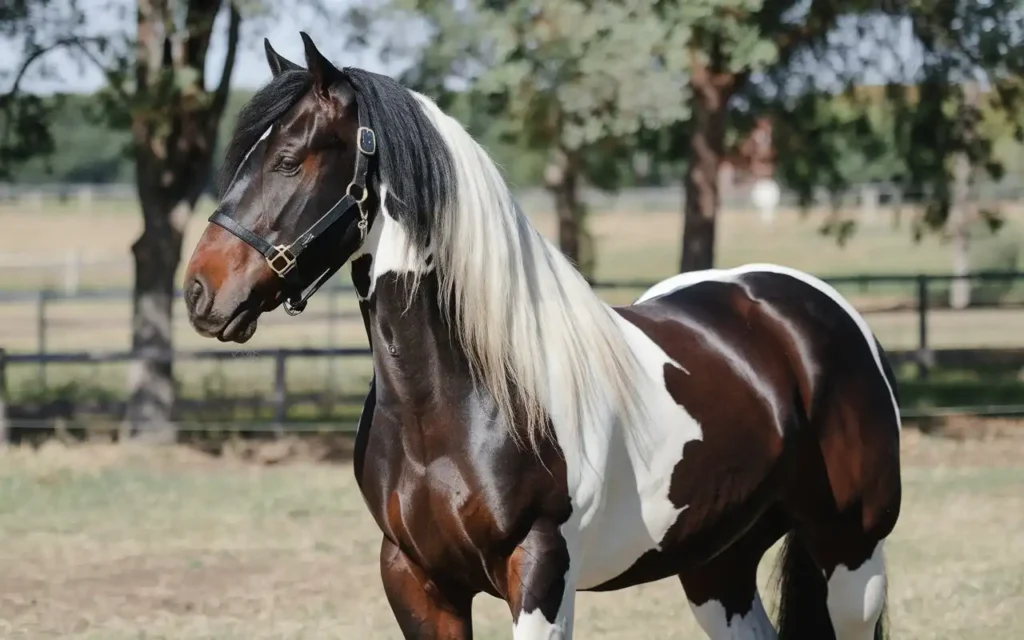
Identifying the Signs of Pigeon Fever in Horses
The symptoms of pigeon fever vary depending on the type and severity of the infection. Early recognition of these symptoms can help start treatment. It can prevent severe health issues. Here are some of the common symptoms associated with pigeon fever in horses:
- External Abscesses: The most common symptom is usually appearing on the chest and abdomen as swollen lumps filled with pus. These abscesses can be painful and may burst if not treated.
- Internal Abscesses: Less visible but far more serious, internal abscesses affect organs like the liver and lungs. Horses with internal abscesses may show signs of weight loss, fever, and lethargy.
- Ulcerative Lymphangitis: A severe form affecting the limbs. It causes painful swelling and, in some cases, open sores along the legs.
If any of these symptoms appear, it is crucial to consult a veterinarian to confirm the diagnosis and begin appropriate treatment.
Types of Pigeon Fever in Horses
There are three main types of pigeon fever in horses, each with unique symptoms and challenges for treatment:
- External Abscess Type: The most common form, characterized by external abscesses along the horse’s chest and abdomen. These abscesses can vary in size and may require surgical drainage.
- Internal Abscess Type: This form is less visible and more dangerous, as the abscesses form inside the horse’s organs. Horses with this type often display general signs of illness, like fever, depression, and loss of appetite.
- Ulcerative Lymphangitis: The rarest but most severe type, this form affects the lymphatic system. It causes inflammation and ulcers along the horse’s legs.
Knowing the specific type of pigeon fever in horses helps vets. It lets them find the best treatment for a quick recovery.
Diagnosing Pigeon Fever in Horses
Diagnosing pigeon fever in horses requires a physical exam, blood tests, and imaging for internal abscesses. If an abscess is visible, vets may take samples. They will use bacterial cultures to confirm the presence of Corynebacterium pseudotuberculosis. Blood tests can reveal elevated white blood cell counts, indicating an immune response, which is common in infected horses.
For suspected internal abscesses, vets may use ultrasound or X-rays to find abscesses in the organs. Accurate diagnosis is vital for guiding treatment, especially for internal infections. These often require intensive care and medication. Knowing the type of pigeon fever helps to determine the prognosis. It also helps to check for complications during recovery.
How Serious is Pigeon Fever in Horses?
Pigeon fever can be mildly uncomfortable or life-threatening. It depends on the type and location of the infection. External abscesses are easier to treat. Most horses recover if the abscesses are drained and managed. However, internal abscesses are riskier. They can harm organ function, causing severe complications or death if untreated.
Early diagnosis and treatment significantly reduce the risk of severe health outcomes. Horse owners should watch for signs of distress in their horses. If symptoms worsen, they should seek veterinary help right away.
Treatment Options for Pigeon Fever in Horses
Pigeon fever treatment usually combines antibiotics, abscess drainage, and supportive care. Here’s a summary of typical treatment approaches:
- Antibiotics: Often prescribed to control bacterial growth, especially for internal abscesses. In contrast, antibiotics for external abscesses are often hindered. This is to avoid prolonging the healing process.
- Drainage of Abscesses: Drainage of external abscesses is often needed. It relieves pressure and removes infection. This process should be done by a veterinarian to prevent further contamination.
- Supportive Care: Doctors sometimes give anti-inflammatory drugs and pain relievers. They reduce swelling and discomfort.
The treatment duration varies. Internal abscesses may take weeks or months to recover from. Consistent follow-up with a veterinarian is essential to ensure that the infection does not return.
Is There a Cure for Pigeon Fever in Horses?
While there is no “cure” for pigeon fever, proper treatment can lead to a full recovery. Horses that get prompt, effective care for abscesses and infections often recover completely. However, some may have scars from the abscesses. Severe infections, especially with internal abscesses, may need long-term treatment. If not all abscesses heal, there is a risk of recurrence.
Veterinary guidance is crucial for managing this disease effectively and preventing further complications. Horse owners should check their horses even after recovery. Reinfection is possible.

Caring for a Horse with Pigeon Fever
Isolating an infected horse is crucial to prevent the spread of pigeon fever to other animals in the stable. Infected horses should be kept away from healthy horses until they have fully recovered. Care routines should include the following steps:
- Hygiene: Antiseptic cleaning of wounds helps to reduce the risk of infection.
- Fly Control: Using fly repellents and fly traps can minimize fly contact and reduce the spread of the bacteria.
- Dedicated Equipment: Do not exchange tools between infected and healthy horses. Bacteria can survive on surfaces.
Proper care helps speed up recovery and limits the spread of infection to other animals.
Preventing Pigeon Fever in Horses
Preventing pigeon fever requires managing the environment. It also means reducing exposure to bacteria. Here are some preventive strategies:
- Stable Cleanliness: Regularly clean and disinfect stalls, especially in the dry season. Soil bacteria are higher then.
- Fly Management: Use insecticides and fly traps around the stable to control flies. This will reduce a major means of spreading disease.
- Monitoring Wounds: Check for open wounds on horses and treat them immediately to prevent bacterial entry.
There is no vaccine. So, preventive care is crucial where pigeon fever is common.
Environmental Factors and Pigeon Fever in Horses
Pigeon fever is more common in areas with hot, dry climates, where the soil bacteria are more likely to survive and thrive. This means that horses in such regions are at a higher risk, especially if they are in dusty environments. Horse owners in these regions should take extra precautions. They should ensure a cool, well-ventilated stable. Also, limit the horse’s exposure to dusty outdoor conditions.
Climate affects infection risk. So, we must manage the environment.
Pigeon Fever in Horses: Long-term Effects
For most horses, the long-term effects of pigeon fever are minimal once they have recovered. Some horses may develop chronic issues, like scar tissue or abscesses. These could harm their performance and comfort. Internal abscesses in horses raise the risk of complications. They may need ongoing care to check for any health issues.
After recovery, it’s best to do regular check-ups. This will catch any signs of reinfection early and maintain the horse’s health.
Role of Fly Control in Preventing Pigeon Fever
Pigeon fever mainly spreads through flies that transmit Corynebacterium pseudotuberculosis. These insects land on the open wounds or infected areas of a horse’s body and carry the bacteria to other horses. This makes fly control one of the most effective methods to prevent the spread of the disease.
There are several ways to manage fly populations:
- Fly Traps: Installing fly traps around the stable and pasture areas can help reduce the number of flies in the vicinity. These traps work well during peak fly seasons.
- Fly Repellents: Applying insect repellents to your horse’s coat can reduce flies. There are many options available, including sprays, gels, and roll-ons. Be sure to choose a repellent that is safe for your horse’s skin and coat.
- Fly Sheets and Masks: In areas with pigeon fever, special fly sheets and masks can protect your horse from flies. These barriers stop flies from landing on the horse’s skin. This reduces the chance of spreading bacteria.
- Proper Waste Management: Flies breed in manure and decaying organic matter. Regularly clean your barn. Remove manure and keep it clean. This reduces places for flies to breed.
These steps can greatly lower the risk of pigeon fever in horses. They will also make your stable safer for all animals.
Manage an Outbreak of Pigeon Fever in a Stable
If a horse in your stable gets pigeon fever, you must contain the outbreak and prevent it from spreading to other horses. Here are several crucial measures you need to implement:
- Isolate the Infected Horse: As soon as pigeon fever is suspected, isolate the infected horse from others to prevent the spread of bacteria. Ensure the infected horse is housed in a separate area, away from other horses, and limit direct contact between them.
- Increase Hygiene Measures: It’s essential to improve the cleaning and disinfecting protocols in your stable. Disinfect any equipment, tack, or grooming tools that touched the infected horse. Then, they can be used with healthy animals.
- Monitor Other Horses: All horses in the stable should be monitored for any signs of illness or symptoms of pigeon fever. Look for swelling, abscesses, or changes in behavior. If other horses develop symptoms, they should be isolated and treated promptly.
- Consult Your Veterinarian: Work with your vet to create a plan for the outbreak. Your vet may recommend testing other horses for the bacteria and administering antibiotics if needed.
By following these guidelines, you can help contain the outbreak and protect the health of your entire stable.
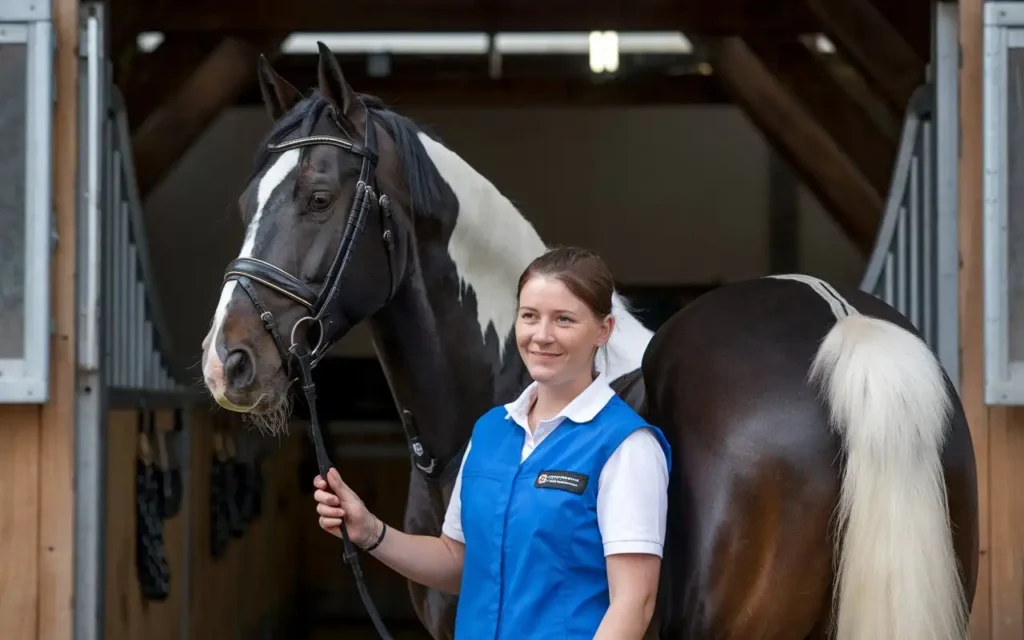
Myths and Facts about Pigeon Fever in Horses
Pigeon fever in horses has many myths and misconceptions. They can confuse and mislead people. Understanding the facts is crucial for horse owners to manage the disease effectively. Here are some myths about pigeon fever, and the facts that clarify them:
Myth 1: Pigeon Fever Only Affects Older or Weak Horses
- Fact: Pigeon fever can affect horses of all ages, breeds, and health statuses. Young foals and older horses with weak immune systems are more at risk. But even healthy adult horses can catch the disease. The bacteria that cause pigeon fever are in the environment. Horses are at risk if they are exposed to infected flies or contaminated soil, regardless of their age or health.
Myth 2: Pigeon Fever is Highly Contagious Between Horses
- Fact: Pigeon fever is not highly contagious between horses in the same way that viral diseases like influenza are. Corynebacterium pseudotuberculosis bacteria spread by flies. But, direct horse-to-horse transmission is rare. Proper fly control and environmental management can significantly reduce the risk of transmission.
Myth 3: Pigeon Fever Can Be Cured with Just Antibiotics
- Fact: Antibiotics can help treat pigeon fever, but they are often not enough on their own. The treatment of pigeon fever usually involves draining abscesses. This includes both internal and external ones. It helps the horse recover fully. Antibiotics may help fight the infection. But, treating abscesses is key to healing. Additionally, supportive care, such as proper nutrition and rest, is often necessary for a full recovery.
Myth 4: Pigeon Fever Only Affects the Chest Area
- Fact: The condition is often linked to swelling in the chest (hence the name “pigeon fever”). But abscesses can develop in other areas, such as the limbs, abdomen, and even internal organs. The name is somewhat misleading, as the infection can occur in many locations.
Myth 5: Horses Can Catch Pigeon Fever From Humans
- Fact: It is extremely rare for humans to contract pigeon fever from horses. The disease is mainly spread by flies, not by direct contact with horses. It is theoretically possible, but rare. Pigeon fever is not a zoonotic disease, meaning it does not typically spread from animals to humans.
Myth 6: Pigeon Fever is Only a Summer Problem
- Fact: Although pigeon fever outbreaks are more common in warmer months when flies are most active, the disease can occur year-round. In colder months, horses may be exposed to infected flies or contaminated areas. This is common in unsanitary barns where flies are still present.
Myth 7: If a Horse Survives Pigeon Fever, It Will Never Get It Again
- Fact: A horse that has recovered from pigeon fever may be more susceptible to re-infection if it is exposed to the bacteria again. The body may not develop lasting immunity. So, always take preventive measures. Control flies and keep wounds clean, even in infected horses.
Myth 8: Pigeon Fever is Only an Issue for Horses in Rural Areas
- Fact: While pigeon fever is more common in rural or agricultural areas, it can affect horses in urban environments as well. Flies can travel long distances, and horses housed in stables, regardless of their location, are at risk if flies are present. The bacteria can survive in the surroundings for an extended period. So, horses in rural and urban areas are at risk if proper precautions are not taken.
Conclusion
Pigeon fever in horses is a serious disease. It needs quick recognition, careful management, and thorough treatment to prevent complications. While the condition can be severe, with the right approach, horses can recover and return to full health. To manage pigeon fever outbreaks and protect horses, we must: 1. Use preventive measures. 2. Detect cases early. 3. Provide proper veterinary care. This is vital for performance and breeding programs.


